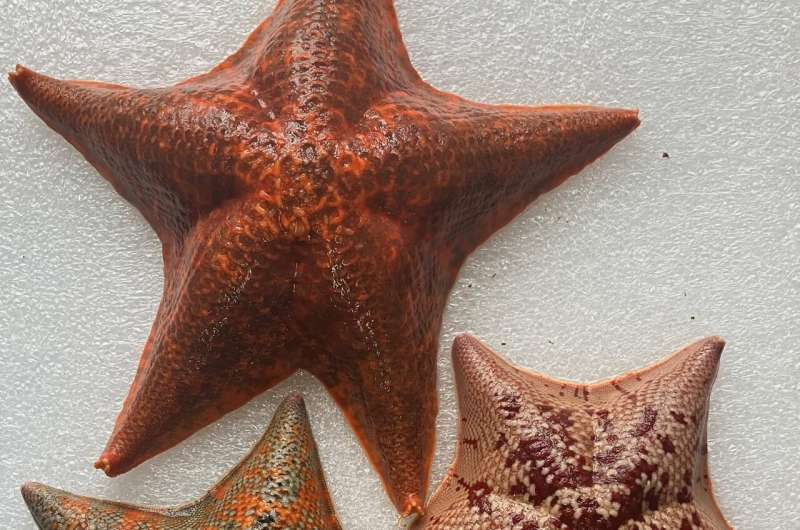This article has been reviewed according to Science X's editorial process and policies. Editors have highlighted the following attributes while ensuring the content's credibility:
fact-checked
peer-reviewed publication
trusted source
proofread
Basic 'toolkit' for organ development is illuminated by sea star

One of the most basic and crucial embryonic processes to unfold in virtually every living organism is the formation of hollow, tubular structures of various kinds. These tubes may form blood vessels or a digestive tract, and through branching and differentiation, complex organs including the heart, kidneys, and mammary glands.
Abnormalities in these processes can cause congenital disorders such as dysfunctional, displaced, or non-symmetrical organs, as well as regeneration defects in blood vessels or in other regenerative organs. Despite its fundamental importance, the general mechanisms of hollow tube formation during embryogenesis are not well understood, due to the great diversity of strategies that animals use to form tubular structures. Enter the sea star, an ancient marine creature whose process of tubulogenesis is relatively easy to study, and which is becoming an important organism for understanding the genetics and mechanics of tube formation.
In the May 9 issue of Nature Communications, Margherita Perillo of the Marine Biological Laboratory (MBL) and collaborators reveal in detail the initiation and early stages of tube formation in the sea star Patiria miniata. "Most of our organs are tubular, because they need to transport fluids or gases or food or blood. And more complex organs like the heart start as a tube and then develop different structures. So, tubulogenesis is a very basic step to form all our organs," Perillo said.
Perillo chose the sea star as a research organism "because I wanted to understand the basic mechanism of tube formation that is conserved across all vertebrates. So I needed an animal that was at the base along the tree of life, [evolving] before the chordates," she said. Using CRISPR and other techniques to analyze gene function, as well as long time-lapse movies of the developing sea star larvae, Perillo and colleagues ascertained how this organism generates tubes that branch out from its gut.
Her study defines a basic toolkit from which the chordate tubular organs may have developed. (Chordates include the vertebrates—fish, amphibians, reptiles, birds and mammals—and a few invertebrate subphyla).
One open question in biology was exactly how organisms develop from one cell into the complex 3D tubular structures of various organs, Perillo said. In some organisms such as flies, "there is a big round of cell proliferation before all the cells start to make very complex migration patterns to elongate, change their shapes, and become a tube," she said.
In other animals, including mammals, cell proliferation and migration occur together. In the case of the sea star, "I found that, in order for tube formation, cells can proliferate and migrate at the same time," as they do in vertebrate development. "So, this means that this mechanism of making organs was already established at the base" or root of the evolution of chordates, she said.
In addition to providing insights into the fundamental process that leads to organ formation, sea stars can serve as a model for much biomedical research, Perillo suggests. For example, she found that a gene called Six1/2 serves as a key regulator of the branching process in tube formation. In mice, knocking out Six1/2 causes kidneys to form abnormally. But researchers have found that mice lacking this gene also resist tumor formation, even when injected with tumor cells. The gene, which is overexpressed in cancer cells, could lead to new ways of studying disease progression, including cancer.
"I can now use this gene to understand not only how our organs develop, but what happens to organs when we have a disease, especially cancer," she says. "My hope is that, in five to 10 years maximum, we will be able to use this gene to test how organs develop cancer and how cancer becomes metastatic."
Sea star embryos have many practical experimental advantages, Perillo said. They are mostly transparent, so internal growth processes can be directly observed over long developmental periods without harming the organism. They are also easy to collect and breed in large numbers year-round, "so I always have a lot of material to work with."
More information: Margherita Perillo et al, Molecular mechanisms of tubulogenesis revealed in the sea star hydro-vascular organ, Nature Communications (2023). DOI: 10.1038/s41467-023-37947-2. www.nature.com/articles/s41467-023-37947-2
Journal information: Nature Communications
Provided by Marine Biological Laboratory

















